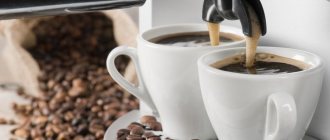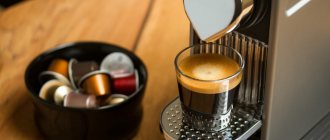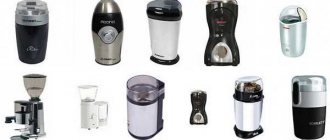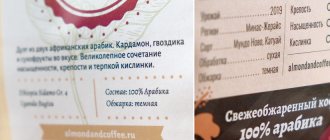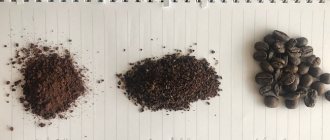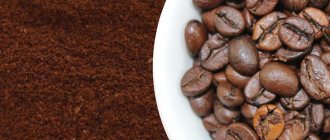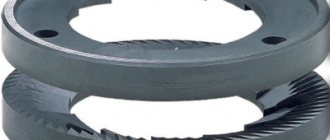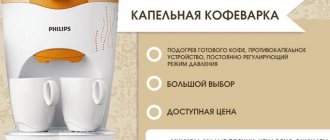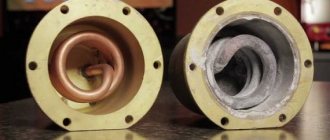After purchasing a professional coffee grinder, the company inevitably comes up with the question of correctly setting the coffee grinder for medium roast. Properly adjusted grinding is the basis for making espresso with a rich bouquet of taste and aroma. It is not always clear how to set the grinding correctly, but this important task does not require much time and effort if you follow a few rules.
Any barista knows that grinding affects the aroma and quality of the drink , so it is important for a coffee professional to be able to competently change the settings of a coffee grinder built into a coffee machine or standing alone. Without this, professional success of a barista is impossible. The choice of grinding is influenced by the method of brewing the drink and external factors: percentage of air humidity, room temperature, atmospheric pressure level. atmospheric conditions.
If you do not change the grind after the percentage of moisture in the air increases, the drink will become bitter because the particles swell, fit closer together and lengthen the brewing time of the coffee. In the case of a decrease in air humidity, the same mistake will lead to the appearance of an unpleasant sourness in the drink, since the coffee beans lose moisture, the distance between the particles becomes larger, and the extraction time of flavoring substances is shortened (not the entire bouquet of taste and aroma is boiled out of the grain).
Making changes to the grinder settings
A coffee grinder has a pair of blades called burrs, the top of which can be adjusted to change how coarse or fine the ground coffee becomes.
Since each coffee has its own specific tendencies and therefore its own sweet spot, it may take a little trial and error to find that sweet spot.
The question of “how to properly adjust the grind on a coffee grinder” and making changes to the grinder settings can be a daunting prospect, however, contrary to many misconceptions, it is actually not such a difficult procedure.
Proper grinding of beans determines the aroma and quality of coffee as a drink. Each type of coffee contains beans of different sizes and densities, and after roasting their moisture level continues to change. The quality of grinding is also affected by changes in environmental factors: humidity, pressure and ambient temperature.
The percentage of air humidity, indoor and outdoor temperatures, and atmospheric pressure levels change throughout the day. Therefore, when adjusting the grinding in a coffee grinder, you need to take into account the season (heat, cold, snow, wind, dryness or rain), room heating, even the operation of the air conditioner and humidifier.
As air humidity increases, coffee granules begin to swell, pressing closer together. This factor increases the extraction time of the coffee, making it bitter. Due to low humidity, on the contrary, the opposite effect occurs: the distance between the granules increases, the coffee cooks faster, reducing the density, and the taste of the drink becomes sour. If the grind is too fine, the coffee will be bitter. Coarse grinding produces watery and unsaturated coffee, and the cream will form a very thin layer.
In this regard, when air humidity increases, you need to change the grinding of the coffee grinder. When indoor humidity increases, the grind needs to be coarser. Otherwise the coffee will become bitter.
With a decrease in air humidity, an unpleasant sourness appears in the drink, as coffee beans lose moisture, the distance between particles becomes greater, and the time for extracting useful substances is shortened. Therefore, the grinding needs to be changed to a finer degree.
We should also not forget about the freshness of the coffee beans and the service life of the coffee grinder, where the millstones have their own expiration date. Worn millstones will produce uneven grinding. Coffee grinder blades need to be changed once a year.
When you need expert help
If you cannot adjust the grinding so that the coffee turns out aromatic and rich, it is better to contact a specialist. The help of a specialist is also necessary in cases where the coffee machine does not pour the drink at all, if the crushed particles of the beans are uneven; The cause may be wear of the millstones, which need to be replaced. There are a number of nuances that can affect the quality of the prepared coffee. In some cases, it is very difficult to understand without experience.
Our service center employs specialists who can quickly find and fix any problem, and the prices are quite reasonable. For example, descaling costs 1,250 rubles, cleaning a coffee grinder - 3,000 rubles, cleaning the brewing unit - from 900 rubles, replacing millstones - from 1,700 rubles. Having extensive experience, our technicians will fix the breakdown in the shortest possible time.
Types of coffee grinding
Coarse grinding (coffee particle size up to 0.8 mm). With this type of grinding, extraction (transfer of soluble substances into the drink) requires 4 minutes.
Medium grind (coffee particle size 0.4 – 0.5 mm). This grind size is called universal. The best extraction time is 4 to 6 minutes.
Fine grinding (coffee particle size up to 0.15 mm). The extraction duration should be 1 - 4 minutes.
Setting the grind size of your coffee grinder is an important and critical step in getting great coffee. The whim of ground coffee is no less than the whim of coffee beans.
Coffee professionals change the grind setting of their coffee grinder several times a day. The reason for this is that coffee, as a good adsorbent, absorbs odors and moisture from the environment. Therefore, the grind cannot be the same at the end and at the beginning of the day.
No one changes the coffee grinder and the barista many times during the day; the only thing the barista “plays” with is the grind. If the grind is very fine, the coffee will flow slowly and will taste very bitter. With coarse grinding, the coffee will spill too quickly and all the necessary components that give the specific taste of coffee will not be transferred into the drink. The drink will be watery, that is, we get underextraction. The cream will also not be stable on the surface. Therefore, you should look for a middle ground.
By adjusting the degree of grinding of the coffee grinder, you can correct excess bitterness or sourness, and achieve more or less richness.
The quality of the drink is also influenced by other factors: grain quality, temperature, water, skill and mood of the barista, and much more.
But other things being equal, it is the degree of grinding that is the value that should regulate all other factors. The grind size is not a constant value; you cannot adjust the coffee grinder once and for all.
The millstones wear out during operation and increase in size due to heating; in addition, the micrometric regulator changes its position due to vibration.
The choice of grind level is influenced by the coffee brewing method. Factors such as brewing time, temperature, pressure are also important.
Balanced all parameters will create the condition that from 18% to 25% of the soluble flavoring components contained in the grain are transferred into the drink. According to the SCAE brew chart, a TDS (refractometer solids concentration) range of 1.15 to 1.35 produces rich, flavorful coffee. This is the central yellow square on the graph.
Automatic devices and grinding
Grinding coffee for a coffee machine has its own characteristics. In most modern devices, the grinding degree is an adjustable function. The regulator sets the level that is suitable for a specific type of coffee. Making the right choice is very important, since the type of grinding significantly affects the taste of the future drink. Coffee shop visitors can only rely on the experience and skill of the barista.
Note. If the coffee machine uses one favorite type of coffee, then the set grinding degree does not need to be changed. It is not prohibited to use it for other varieties and never switch it at all. But then the advantages of the new variety may not be fully revealed. It is undesirable to ignore the availability of switching grain grinding levels.
The time for pouring water to prepare espresso is the same, it does not depend on whether the water passes through large or dusty particles. But the taste of the drink will differ significantly; the size of the “coffee particles” affects it directly and strongly.
The volume of water poured through the thickness of the ground beans also affects the taste of coffee. An increased or decreased amount of liquid passing through particles of different grinding will change the taste of the drink in the cup. The degree of roasting will also affect it; the more intense it is, the more “bitterness” you will feel in the taste.
When to change your coffee grinder grind settings
The coffee grinder grinding settings must be changed in the following cases:
- When changing the type of coffee
- When environmental conditions change: air temperature, humidity level or atmospheric pressure.
- If the coffee grinder blade is worn out.
Coffee grinders never produce a completely uniform grind. Ground coffee will always have larger particles and dust mixed in. To obtain a more or less uniform grind, the ground grain must be passed through a metal sieve of the required diameter. This separates particles that are too large and too small.
Grinding adjustment algorithm
Typically, espresso brewing takes about 25 seconds, so if you don't hit that mark consistently, you'll need to make some adjustments to your grinder settings.
To change settings, follow this simple step-by-step guide:
First, determine whether you need to make the grind finer or coarser.
The grinding on a coffee grinder is adjusted using a disk located under the hopper, that is, a container for storing coffee beans. To obtain a finer grind, only when the device is turned on, the disk is rotated towards the FINE inscription. To make a coarse grind, turn the dial towards the inscription COARSE (GROSS or GROSSA). This is possible with the coffee grinder turned on and off.
- You need to move the disk ring one mark at a time in the appropriate direction.
- First, turn on the disc for ten seconds so that no particles from the previous grind remain.
- Make a test espresso, remembering to keep your dose and tamping technique the same to eliminate any other variables.
- Estimate how long it took to brew this espresso.
- Was the coffee brewed for the optimal time and what does it taste like?
- Repeat if necessary.
Remember that when changing the spacing of the burrs, you must do so in very small increments.
Even three millimeters of movement of the dial can change the extraction time of the coffee by about three to five seconds, so you shouldn't make major changes unless you feel the need to.
Once the best result is found, write down the settings. It's worth writing down because you can use them as your default setting.
Temperature and changing conditions during the working day can sometimes affect the nuances of the coffee, so regular “espresso checks” are suggested to ensure ideal settings are always being used.
Programming permanent settings
In any coffee machine you should enter the programming mode. You can view and execute all the items using the multifunction buttons and the rotary switch.
The following settings are available in this context:
- maintenance – this includes cleaning, decalcification, washing, filter replacement, etc. In the menu you can launch the required program and see all the information about what needs to be done;
- recipe settings – as a rule, classic and advanced parameters are available. Here you should simply replace the starting settings with more convenient and suitable ones;
- coffee machine settings - we are talking about choosing a language, auto shutdown, energy saving mode. Some models offer a choice of units for measuring the amount of water. All this is selected from the menu and saved. If desired, you can return to factory settings. If we talk about automatic shutdown, I advise you to program the time after which the device should turn off. The default is 60 minutes everywhere, but you can extend/shorten this time for convenient operation and saving energy.
What are espresso checks
Before you start changing the settings of a professional coffee grinder, you need to grind the coffee beans for one serving and prepare espresso, measuring the extraction time. If it took less than 22 seconds, then the grind is coarse, if it takes more than 28 seconds, then it is fine.
To determine the quality of the grind, you will need an accurate scale and a stopwatch to determine the coffee extraction time.
To change the grinding settings of the coffee grinder, you need to grind coffee beans for one serving and prepare espresso. In this case, you need to record the time from the moment the espresso is turned on until it ends. If it took less than 22 seconds to prepare the drink, then the grind is coarse; if it takes more than 28 seconds, then the grind is fine.
The ideal extraction time for espresso is 25 seconds. Deviations from the ideal according to specialty coffee standards are ±3 seconds and ±3 ml; ±5 is acceptable in commercial standards. Great if you measure temperature and TDS, but much better if you can judge the appearance and taste of espresso like a pro.
What to do if the machine does not whip up foam?
Engineers say that this problem usually occurs when the unit is not used correctly. This is also considered to be a consequence of errors made by the user when preparing the drink. To avoid defects, we recommend using simple tips.
- Before you start making coffee (especially cappuccino or latte), clean the cappuccino maker from excess water, small debris and waste products. Run bottled water through the foam generator. If a layer of scale has formed on its elements, add special powder or citric acid to the liquid. For greater effect, repeat the procedure 2 times.
- When you notice that the equipment has stopped producing high-quality foam, call a technician from the technical center for diagnostics. There is a possibility that a layer of dried milk has formed on the internal tubes of the device, which does not allow the product to pass through. It is also possible that some parts have become deformed or rusted. An engineer will quickly install this and clean or replace them.
- Do not use boiled water. It prevents the formation of lush foam and changes the taste of coffee. It is best to fill the device with cold liquid or water at room temperature.
If you have any problems with your coffee machine, please contact the A-Iceberg Service Center. Our engineers promptly come to the customer’s home and complete all the work quickly and efficiently. All installed parts are guaranteed.
Source
Recommendations for setting the grind of a professional coffee grinder
Coarse grinding is used to prepare coffee in geyser (steam) coffee makers. For this brewing method, you can also use a medium grind.
Medium grind is suitable for many types of brewing, but is primarily used for French press coffee.
Fine grinding is suitable for espresso and filter (drip) coffee makers.
Powdered ultrafine grinding is used to prepare oriental coffee in Turk (cezve). This is the only type of brewing in which the coffee is served with grounds.
Cunill Tranquilo TRON: adjusting grinding and working with settings
Setting up the Cunill Tranquilo TRON coffee grinder is distinguished by the ability to finely adjust the grind size. The size of the dispensed portion varies from 5 to 12 grams, which allows you to save grain consumption.
The device allows you to set the dose for single and double portions. It is possible to program a third dose option - individual.
The finest grind is ideal for making coffee in a cezve. The coffee grinder does an excellent job of grinding espresso. The ground grains do not clump, the grinding is uniform.
A coarse grind for French press or alternative methods is also highly commendable. The particle diameter is about 3 mm, the grinding is uniform, without dust or other defects.
The coffee grinder gently grinds coffee beans and does not break them, as cheap machines with imitation millstones do. Coffee retains its aroma.
Coffee ground in this machine retains its natural aroma, does not lose its richness, and does not acquire impurities. This characteristic is important for any brewing and grinding method: French press, filter, espresso or cezve.
All of the above advantages are only relevant if you use the highest quality coffee beans. Coffee must be roasted in compliance with all rules, and green beans must meet quality standards.
Each coffee preparation method requires a different grind.
Experts recommend grinding the grains immediately before cooking, since with this grinding the essential oils evaporate much faster.
French press grind: very coarse
The coarsest grind size is suitable for a French press. The particles should be approximately 0.8 mm in size. Soluble substances pass into the drink within 4 minutes. When using medium coarse grinding for a French press, the extraction time must be reduced to 3 minutes. Coffee from this brewing method is distinguished by its dense body, richness in oils, and excellent aroma. To evaluate all the flavor and aroma characteristics of coffee, professionals use a French press.
Grinding for filter coffee makers: coarse
Coarse grinding is suitable for filter machines and drip coffee makers. The Brazilian open cup coffee system also requires a coarse grind. When tasting coffee, the basis is based on drinks prepared using the Brazilian method and from filter coffee makers. This is the grinding standard and brewing methods considered canons. They are well documented in the SCAA, SCAE, COE and WCE regulations.
Grinding for pourovers: medium coarse
For pour overs, Chemex and Clever, the coarsest grind is usually used. Because they use elements of infusion. Extra thick Chemex filter paper allows the coffee to drip slowly. And Clever has a special valve to retain water in the funnel. Therefore, many do not classify them as a pour-over method.
Alternative brewing methods allow for different coffee profiles. The grind size is influenced by the way the filters are folded, the shape of the funnels, and different types and flavors of coffee. The coarser the grind, the higher the temperature, and vice versa, the finer the grind, the lower the temperature. The larger the funnel, the coarser the grind.
For siphon coffee makers, medium-coarse grinding is also used. The drip method with filters also requires a coarser grind.
Universal grinding: medium
Universal, that is, medium grinding, suitable for geyser-type coffee makers (moka), home espresso machines, and carob coffee makers.
The grind is coarser than espresso, but finer than pour over, suitable for Aeropress. Whether the grind is suitable is checked by extraction. If the drink turns out rich and tasty, then everything is fine.
Almost all ground coffee sold has this average grind.
Espresso grind: fine-medium
The method of brewing espresso is the most capricious when it comes to grinding. Almost all drinks are based on espresso and therefore coffee shops are striving to increase their assortment. If the espresso turns out to be frankly bad, then the other drink will not work either.
In the barista championship, espresso was defined as follows: it is a drink prepared in a special coffee machine by passing 25±5 ml of water under a pressure of 9 bar at a temperature range of 85-98°C for 25±5 seconds. through a layer of tightly compacted, finely-ground coffee.
Grinding devices
Manual coffee grinder
Coffee grinders are manual and automatic. The difference between the two is that the manual device is activated by a handle. It is rotated clockwise and the millstones are activated.
The advantage of such coffee grinders is their low cost and autonomous operation. You don't have to look for an outlet or buy batteries.
The disadvantage is that you cannot choose the degree of grinding and obtain powder fractions. Only a medium grind is obtained.
It will not be possible to achieve perfectly ground beans. Some of them will not be completely crushed.
Another disadvantage is that you will have to make an effort to manually grind a large number of grains.
Interesting! Cappuccino with chocolate chips in bags
Electrical device
This coffee grinder is often equipped with an additional function - you can select the degree of grinding using the switch lever.
Also among the advantages is that the unit works independently and ideally grinds grains.
The downside is that it works on the network and the high price.
How to Set Up a Manual Burr Coffee Grinder
How to change the grind size of coffee in a manual conical burr coffee grinder.
To change the degree of grinding, the position of the upper millstone changes, the lower one is stationary.
The degree of grinding in such coffee grinders is changed by increasing or decreasing the distance between the millstones. To increase the size, you need to move the top burr upward, which increases the size of the coffee particles.
To reduce the distance between the millstones, it is shifted down. Too small a distance will lead to rapid wear of the millstones and the device may jam.
Algorithm for moving the upper millstone:
- Remove the handle by unscrewing the nut.
- Remove the washer.
- Depending on the degree of grinding, unscrew or tighten the adjusting nut.
- Return the washer with other elements to their original position.
Coffee dosage
There are two ways to dose the right amount of coffee:
- Approximately. Not available for beginners. Only experienced baristas can accurately determine the dose of ground coffee in the holder.
- At the click of the hopper dispenser. The error of the devices ranges from approximately 0.15 to 0.2 g. The dosage will be different in each serving.
It is ideal to use a high-precision scale to weigh the coffee beans before grinding. These scales are usually sold in jewelry stores and specialty coffee shops.
How to measure a dose of coffee
Ways to measure the right amount of coffee beans:
- Approximately. Unreliable method for beginners. Experienced baristas are able to measure the dose by eye without serious error. Exact dosage is not possible with this option.
- With the click of a coffee hopper. The coffee grinder has an error of 0.2 grams, so the dosage will remain inaccurate and will vary from portion to portion.
The ideal solution for weighing grain before grinding is to use an accurate scale with 0.1 gram increments for this purpose. You can buy inexpensive scales at a jewelry store or specialty coffee shops that are specifically designed for weighing coffee.
You should not try to artificially speed up the process of grinding coffee beans: if you do it too quickly, the grains will be too uneven, which will spoil the taste of the coffee. In addition, quickly ground coffee can heat up, resulting in a bitter drink with a burnt rubber taste .
If you follow all the instructions for proper grinding of beans, you will get coffee with excellent taste characteristics, which guests of the establishment will appreciate. And this will also reduce the consumption of coffee for preparing drinks.
Be sure to read: What water should you use in your coffee shop?
Tips for adjusting grinding
- 1.Change only one variable at a time.
- Change only one parameter that affects the final drink, and leave all the rest unchanged. Parameters such as water temperature, coffee dose and brewing method should remain constant.
- Start by adjusting the grind you previously used.
- When purchasing a new coffee grinder, set the grind to the middle position. This is called the "basic setting". Initially, the manufacturer sets the grinding degree to medium by default. The degree of grinding must be changed in such a way that it is: if the grinding is too fine, set larger values; if too rough, lower values.
- Make small changes to different grinder settings.
- After the first cup with the “base setting”, you need to grind two more cups of coffee. If you grind the first cup in step 20, then grind the next ones in steps 19 and 21. One division of the coffee grinder disk is approximately equal to 2 - 3 seconds. extraction. This division price makes it possible to minimize coffee consumption by adjusting the grinding. To change the settings, you need to move the grinding dial in the desired direction a few notches.
- Before tasting, decide on your taste preferences.
- Try the coffee, recording your sensations of aromas and try the coffee slowly.
- Blends and single varieties are brewed differently and have different aromas and tastes.
- Brew several test batches of coffee.
- At a coffee shop, ask a professional barista to grind some of the coffee beans you bought and use it as a reference when making coffee at home. When learning a new skill, cultivate patience.
The grind setting level depends on the coffee grinder model, so the exact position of the millstones can only be determined experimentally.
Once the setup is complete, there is no need to turn off the coffee grinder. Let it run for a while to remove coffee particles from the machine.
To maximize the preservation of essential oils, grinding the beans must be done 5-10 minutes before the brewing process.
Post Views: 1,547
Water heating level settings in the Jura coffee machine
Preferences in choosing this setting are individual. As a rule, European countries tend to choose low and medium temperatures, while countries like South Africa prefer to set the temperature to almost boiling water.
While settings for the degree of grinding of beans and the intensity of the aroma of coffee directly affect the flavor bouquet of your drink, adjusting the level of water heating is purely a matter of taste. Although it does not change the taste of coffee, it allows you to get maximum pleasure from drinking the prepared drink. Therefore, adjust the water heating level according to your personal preferences. These settings can usually be found in the menu on the display. They are not set using a dial or buttons - this helps prevent other users from resetting saved settings.
